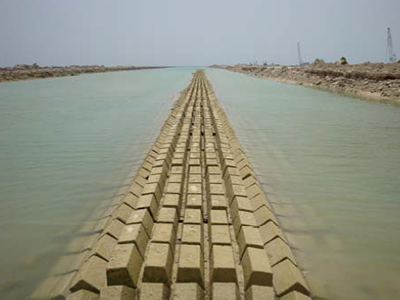 |
This project involved the covering of a 650m-long, high-density polyethylene (HDPE) pipeline for water outfall with 1400mm-diameter Flexmat concrete block mattresses (CBMs). The CBM dimensions were 65 x 30 x 30 cm and included a loop matting fabric (PP80) with 80 kN/m tensile strength.
The flexible concrete mattress consists of high-strength concrete segments linked together with a network of high-strength polypropylene loops connected to a base geotextile to form a continuous, flexible CBM. By comparison, alternative methods of stabilization such as trenching, mechanical anchoring and rock dumping are far more costly and relatively unreliable. (There is a substantial record of failure of these types of systems, particularly in more extreme sea states.) A CBM system with a loop matting construction was found to be a better choice for performance and economics over the use of ropes and metallic ribs to connect flexible concrete and separation geotextile.
Standard CBMs consist of a uniform rectangular pattern of square trapezoidal concrete blocks cast onto durable polypropylene fabric (the loop matting). The matting has excellent durability in water and on land, containing special additives to provide long-term protection against leaching degradation in sea water and UV light.
In order to maximize the project’s economics (and improve project sustainability by limiting the impact from the transportation of materials), the selection of the precast factory was made carefully. The factors used to select the precast factory were:
- Proximity to pipeline location
- Availability of a steam-curing system
- Ability to make the special concrete mix
- A mobile crane (with capacity of at least 10t) for Flexmat roll making and transportation
 |
In this project, CBM used two different kinds of cover for protection pipeline from erosion and damage:
- CBM with 30 cm thickness from shoreline to -2.0m below MWL(mean water level)
- CBM with 20 cm thickness from -2.0 to -15.0 m below MWL
Roll dimensions were specified as 250cm (8.2 ft.) wide by 500cm (16.4 ft.) long. These dimensions were selected based on the diameter of the pipe to be covered (14 in.) and also the capacity of crane and marine installation devices at the site.
INSTALLATION
 |
An advantage of these CBMs is they can be installed in water, but care must still be taken to ensure the highest factor of safety and long-term stability. In marine applications such as at the South Pars Gas Field, the concrete mats should be installed in the opposite direction to the current (or, wave approach direction). This strategy enhances hydrodynamic stability of the CBM rolls.
Underwater Installation
This should ideally be undertaken at the lowest possible tide level or in non-tidal waters at the lowest seasonal water level. With most sites, this decision eliminates the need to use diving gear.
For the South Pars project, the installation rate varied from 5 to 15 rolls installed per day, depending on waves and water depth conditions. CBM rolls were launched from a self-propelled vessel or towed barge by means of a revolving crane and a relatively simple installation frame. This frame was manufactured on the project site.
Performance
Installation of the CBM rolls were started in mid-November and completed within two months. Due to the sensitivity of the site, the monitoring program was stringent; the CBM system passed all of these essential CQA and operational checks.
A major benefit of this pipeline project system approach is that these flexible CBM rolls can be removed and re-installed if there any faults in the pipeline during the project service time. Survivability is one of standalone advantages for CBM systems in comparison to traditional systems, and that contributes further the site’s economic viability.
FINAL NOTES
- The CBM system has been designed and installed successfully to stabilize and protect the 14-in. HDPE pipeline in the South Pars gas field.
- The Flexmat CBM system has provided a highly effective and economical approach when compared to other systems that have been used, such as rock dumping and sand bag units.
- CBM systems can be installed immediately after pipeline sections have been installed, which helps bring the project to conclusion sooner.
- Extensive and accurate design and analysis should be carried out to determine the project-specific dimensions and spans of CBM rolls. This will provide the safest, most effective design and will contribute to project economics and construction efficiency.
- The approach used here is applicable to other scenarios. CBM systems can be extensively used for various water depths and in different storm conditions. The innovative role of a loop-mat geotextile has changed the method of construction and installation in a very good way.
Mohammad Reza Ashgbousi works for Manasanat in the Geotechnics Department. He can be reached at ashkbusi@manasanat.com.












we need for project Concrete Block Mattress (CBM) 2600m2